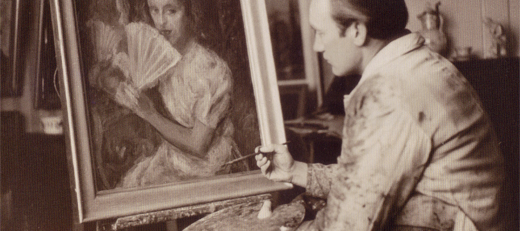Alfred Ziethlow 1911 - 2003

Alfred Ziethlow was born on 18th June, 1911 in Samotschin, District of Kolmar (Chodziez), the Province of Posen (Poznan), where he lived with his family until 1920. He received his artistic training from the following institutions: having finished school in Herne, Westphalia, he attended the Kunstgewerbeschule (School of Arts and Crafts) in Dortmund from 1930 to 1933, the Folkwangschule, Essen, from 1933-1935, the Kunsthochschule (College of Fine Arts) in Bremen from 1935 to 1936, and thereafter, for one year, he was a Meisterschüler (master student) of Professor Heinrich Nauen at the Kunstakademie (Academy of Arts), Düsseldorf.
Following the death of his father, the young artist moved to Münster in Westphalia. He earned his living as freelance artist and industrial designer.
After the outbreak of war, he was drafted for military service, and was to be stationed in Russia from 1941 to 1943. However, in 1942 he fell ill and moved to Munich, where he had a studio in the Sendlinger Straße. All his works stored there were destroyed by fire during the disastrous bomb attack on the city.
For a short period he returned to Samotschin, the place of his birth, but in 1944 fled from there to Horn/Principality of Lippe.
In the years from 1945 to 1950 he worked as a freelance painter, and as the director of his own advertising agency. He was very active in the local art scene, and was a member of the “Lippische Künstlerbund” (Association of Artists in Lippe), the “Werbefachverband/Westfalen” (Advertising Association of Westphalia) and the “Landesberufsverband bildender Künstler Nordrhein-Westfalen” (North Rhine-Westphalian Trade Association for Visual Artists). In 1949 he became one of the founding members of the so-called “freie Gruppe” (free group), consisting of artists who presented their works in group exhibitions; members were, inter alia, Emil Schumacher, Karl Otto Götz and Thomas Grochowiak. In 1950, Ziethlow moved back to Münster where, in addition to his artistic activities, he was a specialist teacher for art and advertising at the Städtische Handelslehranstalten (the city’s commercial schools). Until his death at the age of 92, he lived and worked in the Westphalian city of Bad Salzuflen.
Ziethlow’s oeuvre as a freelance artist consists of numerous oil paintings and water colours, as well as graphic works, etchings, lithographies and serigraphies. At all times, the artist insisted on highest quality materials with the result, that even today his works maintain their colour freshness.
His excellent professional training is reflected in all his works. Without any doubt, Ziethlow belongs to the category of “classics” and “traditionalists”. He hardly felt urged on by the hectic activities of the avant-garde, and was not at all influenced by the American movements of abstract expressionism and Pop Art. And even though there exist some abstract compositions, all in all he remained loyal to representational painting.
Ziethlow painted passionately, with utmost loyalty to art and art history, which he never questioned. His numerous travels inspired this outstanding painter and water-colourist. He created on-the-spot sketches and watercolours with a spontaneous and sure stroke of the brush, in minute detail, never in mere outline. In the spontaneous, never to be corrected watercolours, the superb mastery of the artist is revealed. Thus, Ziethlow endeavoured to catch impressions of landscape and architecture, as well as moments of everyday life of people in streets and places, in order to transform them in his studio into oil paintings on canvas. Thus, works were created which to this very moment entice with their richness in motifs, their genuinely artistic form language and high technical quality. Idyllic landscapes, colourful still lives, psychologically sensitive portraits, active life of modern urban dwellers, scenes of harbours and streets – images of life, to be understood only in their totality. In his light wet in wet painted watercolours, but also in his strong pastose oil paintings, the colour composition is always most important. Colour surfaces, set next to each other, colourist wealth freed from its object, colour as a constructive element – so to speak, paintings “absolute” – these are the features which best describe Ziethlow’s works, so very rich in composition.
